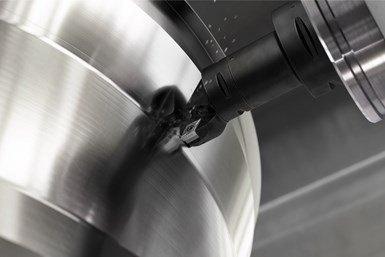Sandvik Coromant Inserts Provide Stable Turning of Aerospace Components
The new insert grades GC1205 and GC1210 cover a large application area within last-stage machining and intermediate-stage machining when turning aerospace engine components.
Sandvik Coromant has introduced two new physical vapor deposition (PVD) insert grades, GC1205 and GC1210, designed for secure, high-precision turning of aged, nickel-based, heat-resistant superalloys (HRSA).
The new insert grades GC1205 and GC1210 cover a large application area within last-stage machining (LSM) and intermediate-stage machining (ISM) when turning aerospace engine components.
Several key features help in working with the high-level performance of HRSA materials, including a hard, fine-grained new substrate, the latest PVD coating technology and optimized edge-line integrity. These features provide increased flank wear and secondary notch wear resistance, superior edge-line security and reduced flaking.
“For our customers, this translates into possibilities to run the inserts at higher cutting speeds with GC1205 and increased tool life with GC1210. Additionally, it ensures consistent and predictable tool life while reaching the required surface integrity demands for critical aerospace components,” says Martin Saunders, global product application specialist for turning at Sandvik Coromant.
The insert grades GC1205 and GC1210 are well suited for machining typical aerospace components, such as gas turbine discs, casings, blisks, spools, shafts and blades, and are said to perform well in more demanding applications including power generation turbines and medical implants made of cobalt-chrome.
GC1205 is a finishing grade for machined surfaces in LSM and ISM applications. GC1210 complements GC1205 when more toughness is required and is mainly used in ISM applications for non-machined surfaces.
RELATED CONTENT
-
Walter Ceramic Inserts Enable Efficient Turning, Milling
Suitable turning and milling applications of the WIS30 ceramic grade include roughing, semi-finishing and finishing, as well as interrupted cuts.
-
Tungaloy CBN Inserts Boost Productivity in Hard Part Turning
The company has upgraded its MiniForceTurn by introducing 30 new DXGQ/U0703 inserts with brazed CBN tips and an HP chipbreaker.
-
Absolute Machine Tools Turning Center Provides Improved Chip Removal
Johnford SL-300L-II slant-bed turning centers are constructed with a one-piece Meehanite cast iron base for strength and rigidity, as well as to dissipate heat away from the part.




